|
When I think of a Navy
(or Air Force, or Army, or Marine, or Coast Guard) test pilot, what comes to
mind is a high powered fighter airplane, a bomber, or even maybe a helicopter,
but the guys in this 1937 Popular Mechanics magazine article are
proving cargo and personnel type seaplanes. Doing so might not be as glorious as
the aforementioned types, but it is still no job for the weak of heart or slow
of mind. The average lifetime of a test pilot is less than that of "regular"
pilots because not only are new, untried concepts tested, but part of the
wringing out procedure involves pushing the craft to its limits to determine
whether the design goals were met, and to know what the placarded "never exceed"
numbers should be. Many a test pilot perished during the final "10-G" stress
tests of airplanes during World War I, which is quite a demand from what were
usually stick and tissue (spruce and silk, actually) airframes.
Thrills of the Navy Test Pilots

Pilot at controls of flying boat.
What happens to a twenty-ton flying boat if it is slammed into mountainous waves
while going seventy miles per hour?
Nothing, if the boat is as sturdy as her designers think and the pilot is one
of the best in the world.
Tumbling a big transport around in the sky is just routine to a test pilot, but
taking a big flying boat out for her rough-water landings is something that always
packs a thrill. This supreme test is part of the Navy's requirements because when
one of the big "ducks" goes to the rescue of a plane or ship in distress it is usually
in bad weather. The pilot has to know that his boat can take a terrific beating
and get back up into the air again safely. That's why the pilot picks rough water
for his proving ground. Waves twenty or thirty feet high are ideal. Smacking into
the hills of solid water will rip the bottom out if the hull is poorly built. The
crash of landing may bend the wings down in a permanent curve or even tear the motors
loose from their mountings. If something goes wrong the pilot may be able to taxi
back home on the surface, or he may have to send out a radio plea for help.
What's it like to crash one of the big boats on purpose? For one thing, your
safety belt must be around you and tightly fastened. The boat hits with a smash
and throwing motion that tosses everything around. Men who have tried to stand up
during a rough landing have broken their ankles. Mingled with the thunder of the
impact is the screech of metal as it strains under the shock. The jar of landing
imposes the same terrific strains that a terminal velocity pull-out gives to a fighting
plane. In test pilot lingo, the impact may amount to eight or nine "Gs," which means
that the boat and crew are subjected to a pull of eight or nine times normal gravity.
"Getting down safely is a touch-and-go maneuver that you can't plan out ahead
of time," one pilot says. "It all depends on the directions the wind and waves are
running. Sometimes it is best to land into the wind and take your chances with the
waves. But if they are running too high you have to land parallel with them and
fight the cross wind. If you catch the bow in a wave it may cave in like an eggshell.
A stray wave crest may flick a wing pontoon off cleanly.
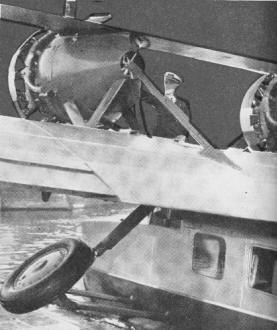
Engines of flying boats and amphibians are mounted high above
water to avoid spray.
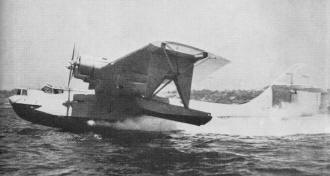
Big flying boat getting up speed for the take-off.
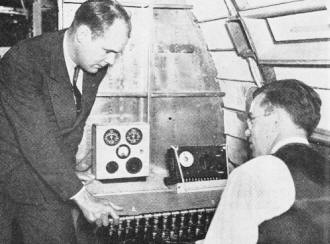
Pilot confers with engine inspector after completing tests on
plane.

Seaplane landing in a cloud of spray in rough sea.
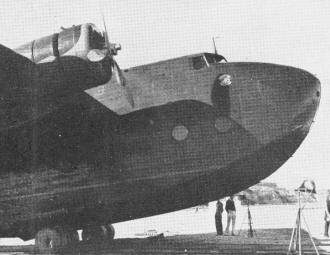
Big flying boat on its beaching gear.
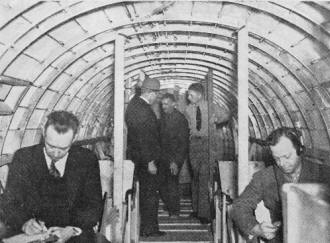
Temporary interior finish of air liner while undergoing government
tests.
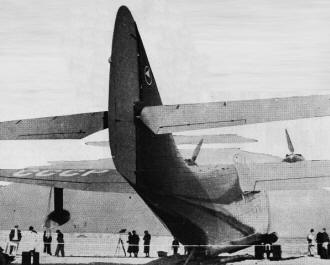
Tail group of giant Douglas flying boat on the beach.
"The best way to land is between the crests and you try to drop the boat in solidly.
A good landing is a two-point landing and the pilot can pick out the 'slap slap'
of the hull as it touches first on the heel and then on the toe. One minute you
are flying a big airplane and the next you are struggling with the controls of a
bouncing boat, trying to kill its speed and face around into the waves without getting
a wing under."
Pilots find that the best way is to drop the boat into the water from a three
or four-foot height so that the water can get a good grip on the hull and slow it
down. If the pilot makes a bad guess and hits the heaving surface with too much
speed or at the wrong angle the huge boat slams through the water like a skipping
stone. It may bounce back up into the air time after time.
Once the fuel line of a single-engined boat broke while the boat was flying off
Haiti. The pilot came down into the water at fifty miles per hour.
There was a heavy sea running and the boat hit hard, bouncing thirty feet into
the air. The pilot fought to keep the wings level and down the ship went again,
this time bouncing ten feet. On the next drop the boat stayed down. The three crashes
buckled the motor struts and the boat was in no condition to fly, so the radio operator
got off an emergency message and the rest of the crew broke out a sea anchor. They
rode it out until they were rescued next day. That was several years ago. Today
the big boats must be able to take even worse beatings without damage.
"Even more exciting than a landing is a rough-water take-off," one of the pilots
says. "Just how you do it all depends on the wind and waves. In a heavy storm you
may have to ride it until things calm down a bit. Usually you try to take off into
the wind although sometimes you make a downwind take-off. Other times the boat may
lift easiest in a cross wind and then you guide the plane to follow along a wave
crest while you get up flying speed.
"In a take-off directly into the wind and waves you get what amounts to a high-speed
roller-coaster ride. One minute you are on a crest looking down into a deep valley
right under the boat and the next you are down in the hollow climbing the next wave.
The motors are on full and the high scream of the propellers seems to go right through
your head. As you get up flying speed the boat begins to skip across the hollows
and land on the other slopes. You hit a wave crest and the crash of the water against
the hull below and behind the cockpit sounds like the boom of a cannon. The plane
staggers. Sheets of spray explode upward over the wings. You can't see through the
flying water but you have already pulled the nose of the boat up to prevent crushing
it and now you nose down again to regain speed. You have to remember to keep the
wings level because getting a wing under just now would mean the end of the trip.
You smash into a few more wave crests and then begin to pull up over them. Finally
you are safely in the air."
Each kind of plane requires a different technique to get off the water. A small
single-float seaplane is different from a big boat and the pilot makes a "stall"
take-off, pulling the stick back at the right moment and bouncing up into the air.
An inexperienced pilot may try for hours to get a flying boat up into the air if
the water is rough. He has to be told at just which angle to cut across the waves
in order to get off. The big boat pilots haven't any convenient wind socks to tell
them which way the wind is blowing. The smoke from a steamer may be a guide and
otherwise they have to read wind direction by hunting for streaks of foam on the
surface or by watching the spray pulled off wave crests. A dead calm in which the
water is glassy still calls for a "hot" landing that takes nearly as much skill
as sitting down on rough water. The surface looks like a mirror to the pilot and
he can't tell whether he is two or fifty feet in the air. If he levels off too soon
his bad guess would wreck the boat, so he flies downhill as slowly as he can with
power on until he hits. The shape of the hull helps absorb the shock.
In a dead calm, also, a pilot may have a hard time getting off again. When the
water is flat a boat sometimes can't break itself loose from the surface. In that
case the pilot taxis around in fast tight circles to stir up the water, then makes
a fast take-off run across the circles.
Being a surface craft as well as an air-plane, a flying boat gets all sorts of
tests that no land plane is ever given. When a new Douglas flying boat is launched
for its tests the first routine is to find out how it handles on the water. A full
crew of pilots and engineers climb on board. At the controls may be Glen Moser,
chief pilot, and alongside him Al Reid, co-pilot and engineer. Mike Hunt and another
mechanic stand by in the cabin, while Schuyler Kleinhans, project engineer, and
several observers strap themselves into the seats.
A good duck should handle just like a boat on the surface. First of all Moser
simply taxis around on the water and makes left and right turns across the wind.
He wants to know how much rudder control is needed to swing the boat. Then he tries
turns using one engine as well as the rudder to turn the plane. From the cabin windows
the engineers watch the wing pontoons, which are retractable into the wings these
days, to find out whether they are large enough and strong enough to keep a wing
from dipping under.
No airplane has a reverse on it but the big boats can sail backward down wind
by allowing the engines to idle. Another test is to turn tail to the breeze and
taxi slowly down wind. The big control surfaces of the tail are apt to catch the
wind and make the plane yaw around, and the pilot has to know how much control is
necessary to hold a straight course. Next come the high-speed taxi tests with the
plane churning along through the water on its step just under fifty miles per hour.
No turns are made at these high speeds and the courses are straight runs into the
wind and out of it. With unlimited water in front of him a pilot can take off with
the wind behind, something not recommended for land planes.
The first few flights are made with no other load but the crew, merely to learn
how the boat handles in the air and to check the instruments and controls. Usually
small details have to be adjusted and after that whole groups of tests are made
while the boat carries increasingly larger loads of lead bars. The engineers want
to know the safe minimum flying speeds for all loads, rates of climb and descent,
take-off time, ceiling and maximum speeds. To check and calibrate the air-speed
indicators the pilot races along a speed course marked out on the beach with a stop
watch in his hand to mark his elapsed time. With a full load of 28,500 pounds on
board, one of the new twin-engined Douglas boats climbs 600 feet per minute and
has a high speed of 185 miles per hour. Flying boats can lift heavier loads into
the air then land planes because they have all the take-off room in the world.
Just like other large surface boats, flying boats have watertight doors in their
hulls. On the Douglas the six different compartments are sealed with light strong
doors that can be closed or opened in a few seconds. A lightweight collapsible anchor,
a bilge pump, life belts, boat hook, and signaling flares are included in the marine
equipment.
Posted January 20, 2024
|